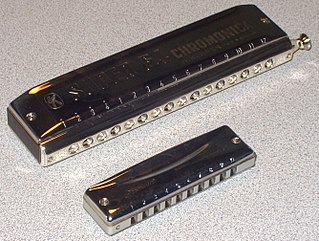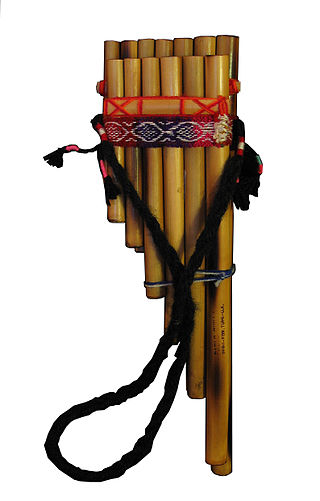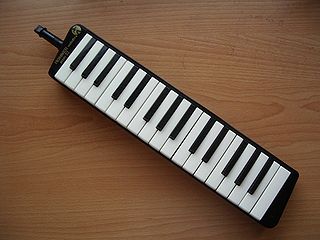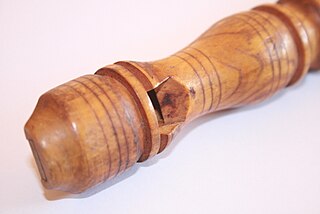
The didgeridoo, also spelt didjeridu, among other variants, is a wind instrument, played with vibrating lips to produce a continuous drone while using a special breathing technique called circular breathing. The didgeridoo was developed by Aboriginal peoples of northern Australia at least 1,000 years ago, and is now in use around the world, though still most strongly associated with Indigenous Australian music. In the Yolŋu languages of the indigenous people of northeast Arnhem Land the name for the instrument is the yiḏaki, or more recently by some, mandapul. In the Bininj Kunwok language of West Arnhem Land it is known as mako.

The flute is a member of a family of musical instruments in the woodwind group. Like all woodwinds, flutes are aerophones, producing sound with a vibrating column of air. Flutes produce sound when the player's air flows across an opening. In the Hornbostel–Sachs classification system, flutes are edge-blown aerophones. A musician who plays the flute is called a flautist or flutist.

The harmonica, also known as a French harp or mouth organ, is a free reed wind instrument used worldwide in many musical genres, notably in blues, American folk music, classical music, jazz, country, and rock. The many types of harmonica include diatonic, chromatic, tremolo, octave, orchestral, and bass versions. A harmonica is played by using the mouth to direct air into or out of one holes along a mouthpiece. Behind each hole is a chamber containing at least one reed. The most common is the diatonic Richter-tuned with ten air passages and twenty reeds, often called the blues harp. A harmonica reed is a flat, elongated spring typically made of brass, stainless steel, or bronze, which is secured at one end over a slot that serves as an airway. When the free end is made to vibrate by the player's air, it alternately blocks and unblocks the airway to produce sound.

A pan flute is a musical instrument based on the principle of the closed tube, consisting of multiple pipes of gradually increasing length. Multiple varieties of pan flutes have been popular as folk instruments. The pipes are typically made from bamboo, giant cane, or local reeds. Other materials include wood, plastic, metal, and clay.

A percussion instrument is a musical instrument that is sounded by being struck or scraped by a beater including attached or enclosed beaters or rattles struck, scraped or rubbed by hand or struck against another similar instrument. Excluding zoomusicological instruments and the human voice, the percussion family is believed to include the oldest musical instruments. In spite of being a very common term to designate instruments, and to relate them to their players, the percussionists, percussion is not a systematic classificatory category of instruments, as described by the scientific field of organology. It is shown below that percussion instruments may belong to the organological classes of idiophone, membranophone, aerophone and chordophone.

The tin whistle, also known as the penny whistle, is a simple six-holed woodwind instrument. It is a type of fipple flute, putting it in the same class as the recorder, Native American flute, and other woodwind instruments that meet such criteria. A tin whistle player is called a whistler. The tin whistle is closely associated with Irish traditional music and Celtic music. Other names for the instrument are the flageolet, English flageolet, Scottish penny whistle, tin flageolet, or Irish whistle.

In musical instrument classification, string instruments, or chordophones, are musical instruments that produce sound from vibrating strings when a performer strums, plucks, strikes or sounds the strings in varying manners.

The melodica is a handheld free-reed instrument similar to a pump organ or harmonica. It features a musical keyboard on top, and is played by blowing air through a mouthpiece that fits into a hole in the side of the instrument. The keyboard usually covers two or three octaves. Melodicas are small, lightweight, and portable, and many are designed for children to play. They are popular in music education programs, especially in Asia. The modern form of the instrument was invented by Hohner in the late 1950s, though similar instruments have been known in Italy since the 19th century.

A jug band is a band employing a jug player and a mix of conventional and homemade instruments. These homemade instruments are ordinary objects adapted to or modified for making sound, like the washtub bass, washboard, spoons, bones, stovepipe, jew's harp, and comb and tissue paper. The term 'jug band' is loosely used in referring to ensembles that also incorporate homemade instruments, but that are more accurately called skiffle bands, spasm bands, or juke bands because they do not include a jug player.

An aerophone is a musical instrument that produces sound primarily by causing a body of air to vibrate, without the use of strings or membranes, and without the vibration of the instrument itself adding considerably to the sound.

The ocarina is a wind musical instrument; it is a type of vessel flute. Variations exist, but a typical ocarina is an enclosed space with four to twelve finger holes and a mouthpiece that projects from the body. It is traditionally made from clay or ceramic, but other materials are also used, such as plastic, wood, glass, metal, or bone.

The term fipple specifies a variety of end-blown flute that includes the flageolet, recorder, and tin whistle. The Hornbostel–Sachs system for classifying musical instruments places this group under the heading "Flutes with duct or duct flutes." The label "fipple flute" is frequently applied to members of the subgroup but there is no general agreement about the structural detail of the sound-producing mechanism that constitutes the fipple, itself.

The bazooka is a brass musical instrument several feet in length which incorporates telescopic tubing like the trombone. Radio comedian Bob Burns is credited with inventing the instrument in the 1910s, and popularized it in the 1930s. It was also played by jazz musicians Noon Johnson and Sanford Kendrick.

An organ pipe is a sound-producing element of the pipe organ that resonates at a specific pitch when pressurized air is driven through it. Each pipe is tuned to a note of the musical scale. A set of organ pipes of similar timbre comprising the complete scale is known as a rank; one or more ranks constitutes a stop.

A wind instrument is a musical instrument that contains some type of resonator in which a column of air is set into vibration by the player blowing into a mouthpiece set at or near the end of the resonator. The pitch of the vibration is determined by the length of the tube and by manual modifications of the effective length of the vibrating column of air. In the case of some wind instruments, sound is produced by blowing through a reed; others require buzzing into a metal mouthpiece, while yet others require the player to blow into a hole at an edge, which splits the air column and creates the sound.

Modern didgeridoo designs are distinct from the traditional Australian Aboriginal didgeridoo, and are innovations recognized by musicologists. Didgeridoo design innovation started in the late 20th century using non-traditional materials and non-traditional shapes. The design changes include features that are similar to more familiar musical instruments like the trombone and natural horn.

A shepherd's whistle is a specialized, modulatable, variable-pitch whistle used to train and transmit commands to working dogs and other animals. Unlike other whistles, they are placed inside the mouth. The pitch is controlled by the placement of the tongue; physically, shepherd's whistles are vessel flutes with the tongue forming one side of the resonating chamber, and controlling its size. Like tin whistles, while simple, they can be used as musical instruments in their own right.

A vessel flute is a type of flute with a body which acts as a Helmholtz resonator. The body is vessel-shaped, not tube- or cone-shaped; that is, the far end is closed.

Music technology is the study or the use of any device, mechanism, machine or tool by a musician or composer to make or perform music; to compose, notate, playback or record songs or pieces; or to analyze or edit music.



















